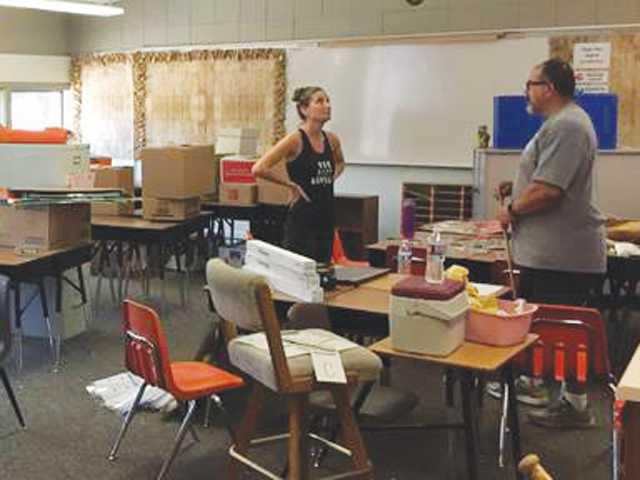The race to prepare for the new school year today saw workmen and teachers alike at the five Manteca Unified elementary schools undergoing modernization scrambling to prepare for students.
Tasks such as placing new carpet in modernized classrooms were taking place in the waning hours of the last afternoon of summer vacation on Wednesday.
Work will continue throughout the coming months for the first wave of Measure G projects at Lincoln, Lathrop, Shasta, Sequoia and Golden West elementary schools. The initial $56.4 million in projects are being funded with the $159 million bond measure voters approve 20 months ago.
At Golden West and Shasta — last modernized respectively in 1996 and 1999 — both new construction and modernized classrooms have played a pivotal role. The modernization plan has been conducted in phases that have required teacher flexibility to relocate as needed.
“There is excitement, especially when they walk through the new entrance area,” shared Lathrop Elementary Principal David Silveira of the campus last modernized in 1989. “There is new flooring, new lighting, and the new sinks. Everything is new. We are ready to go and are excited about parking, security, and facilities improvements. The office is now more central on the site too. It has been tough, but we are ready to go.”
Lincoln Elementary was last modernized in 1989.
“This Lincoln staff is amazing,” Lincoln Principal Steve Anderson said. “I have been so impressed with the attitude and flexibility of all staff! They all have embraced the differences and challenges as opportunities to provide an even better learning environment for our families and students. Their creativity is amazing. The classrooms are fresh, clean, student appealing and very safe.”
“This Lincoln custodial staff is awesome,” Anderson added. “They continue to work all hours of the day to make Lincoln School a safe and clean place for student learning. Lincoln School is not complete, but the final project will be a beautiful setting and facility for our Lincoln School community, students and families.”
At Sequoia, last modernized in 1989, the modernizations to existing classrooms included changes in plumbing, wiring, heating and air-conditioning, flooring, and cabinetry. As teachers came back to work, the process of moving their classroom and curriculum supplies was a team effort.
Principal Chrissy Rotert explained, “My Vice Principal was helping me move boxes this morning.” Her mother and other family friends were also present to help move boxes and clean her classroom.
In the kindergarten rooms, brightly colored floor tiles accompany the newly painted walls with school colors. New cabinet doors to existing shelving and new countertops add to the feeling of newness and excitement.
New digital touchscreen thermostats are a welcome addition and part of the district’s efforts at making heating and air-conditioning more energy efficient.
Fourth grade teacher Alicia Uecker, who was moved from a portable classroom to one of the modernized rooms, smiled broadly when she said, “I am so happy the air is working! I also have running water now for science and art projects.”
Uecker said that her bulletin boards are ready, and so will the rest of her room be for students today.
“We are able to get a lot of work done over the summer, but these are long-term projects that are bigger than summer work,” said Clarke Burke, Deputy Superintendent of Personnel and Operations. “We are rallying the troops to support the kids in coming back to school.”
As an ongoing project, the new Sequoia administration building with additional classrooms is scheduled to be completed in October of this year. At that point, what is considered the front of the campus will be on the opposite side where solar panels shade parking spots for staff, faculty, and visitors.
Schools sprint for student success





